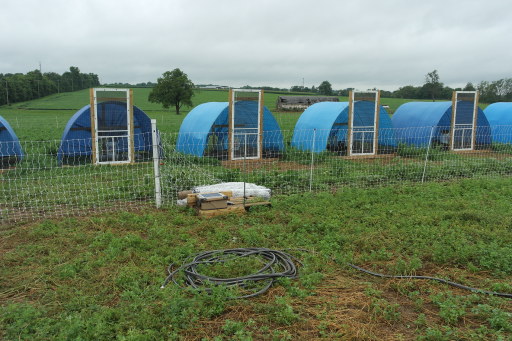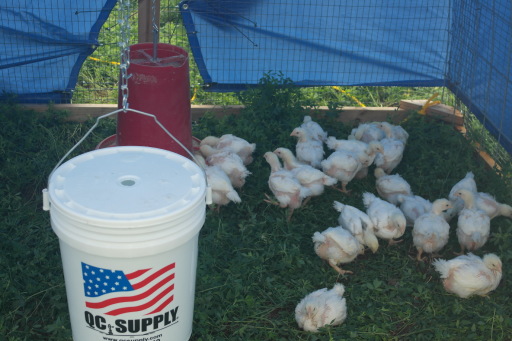First of a three part series. Dr. Jacquie Jacob shares her research on how to effectively use heritage breeds for small-scale meat production operations. Here’s a link to Part 2.

Three heritage breeds used for broiler flocks: Rhode Island Reds, Black Australorps, Barred Plymouth Rocks. Photos by Stephen Patton, University of Kentucky
Small-Scale Chicken Production
Small-scale broiler chicken enterprises are often competing with large commercial companies for a share of the consumer market. But there are ways that small producers can differentiate themselves and make clear to consumers why their chickens are attractive purchases. The research being presented here is part of an overall project at the University of Kentucky to develop alternative production systems for small-scale commercial poultry businesses in the United States.
Many small-scale producers use the same fast-growing chicken found in most commercial operations: a hybrid Cornish/Plymouth Rock strain. Hybrid chicks are readily available for purchase, easily shipped, have a fast growth rate, and higher feed efficiency. The fast-growing chickens, even when raised on pasture, require less than seven weeks to reach market weight. However, at 7 weeks of age, the chicken is far from reaching sexual maturity, which typically happens around 20 weeks of age, and as a result, most of the chicken meat has a bland flavor. Small-scale producers are looking for alternative options to produce a tastier bird for niche markets where they can get a premium price.
Producing Tasty Birds
Some small-scale farmers are opting to use heritage breeds: chickens that haven’t been primarily selected for their fast growth rate. In this study, we looked at three heritage breeds: Black Australorp, Barred Plymouth Rock, and Rhode Island Red. The Black Australorp was chosen because it has dark-colored shanks and black feathers. It’s particularly popular with the growing ethnic market for these reasons. The Barred Plymouth Rock and Rhode Island Red breeds were selected because they’re considered dual-purpose breeds. The females are reasonably good egg producers, and both females and males have a considerable amount of meat on them, though not as much as commercial hybrids. Although the heritage breeds grow slower than the commercial meat chicken and thus require more feed per pound for weight gain, they typically have better livability in alternative production systems, such as pasture production. In addition, due to the longer growth period, the meat typically has more flavor.
Study Specifics
For this study, we compared these three heritage breeds to the commercial-type meat chicken (the Cornish/Plymouth Rock hybrid). Some batches of chickens were raised strictly in floor pens, while others were initially raised in pens and then moved to pastured enclosures for the remainder of the grow out period (a total of 14 weeks for heritage breeds and 7 weeks for commercial-type chickens). This is known as a four-by-two factorial research study: four different types of chickens and two different management systems. Additionally, we repeat each factor to provide enough data for statistical analysis. For example, three groups of Australorps were raised in pens and another three groups finished on pastures for a total of six Australorp groups. A statistical analysis of the data collected is done to see if any numerical differences in treatments are “real,” and thus likely to occur again under similar situations.
We wanted all the breeds to be on the same pasture and reach market weight at the same time. Because of the faster growth rate of the commercial strain of chicks, they were started seven weeks after the heritage breeds. This allowed for all the chickens to be finished on pasture at the same time.
Starting with Chicks
Newly hatched chicks aren’t able to regulate their body temperature. As a result, indoor brooding is required to get them off to a good start. Because of the time of year and the associated weather in Kentucky, the heritage chickens were brooded in floor pens until they were 4 weeks old. At that time, each group of chicks was split, with half remaining in the floor pens and half being placed in pasture pens. When the heritage chickens were 7 weeks old, the commercial-type chicks were similarly placed in floor pens. At 3 weeks of age, half the commercial breed chicks remained in the floor pens and half were placed in pasture pens alongside the heritage chickens. All chickens received the same diet and lived on the same alfalfa pasture.
Although we started the commercial strain seven weeks after the heritage breeds, they had considerably higher final body weights at the end of the trial. The commercial strain chickens averaged 2,665 grams (5.9 pounds) after seven weeks, while the heritage breeds averaged only 1,795 grams (4.0 pounds) after 14 weeks. In hindsight, we should have started the commercial chicken breeds even later, to ensure that all the chickens had approximately the same market weight.
Comparing Results of Housing
When we compared the commercial-type chickens raised completely in floor pens with those finished on pasture, we found that placing 3-week-old chickens on pasture initially reduced growth rates. But by the end of the study, the pasture-raised chickens had higher body weights (2,840 grams, or 6.3 pounds) than those raised indoors (2,491 grams, or 5.5 pounds). Overall, however, the amount of feed required by the commercial-type chickens to produce 1 pound of growth (referred to as “feed efficiency”) was not significantly different for the two groups, averaging 2.14 pounds. This is still higher than feed efficiencies typical for conventional producers. The actual feed efficiency achieved by any producer will depend on the final market weight of the chickens produced.


Pasture pens: electric fence around the group of hoop pens. Photos by Jacquie Jacob
For the heritage breeds, there were no statistically significant differences between the final body weights of the chickens finished on pasture and those raised indoors. There were, however, differences in total feed consumed, and thus feed efficiency. The most efficient were the Black Australorps—with no differences between those that finished on pasture and those raised indoors—averaging 3.53. The Barred Plymouth Rocks were the next best in feed efficiency—again with no differences between the two production systems—averaging 4.16. The Rhode Island Reds were the least efficient of the heritage breeds, and we noticed quite a difference between floor-raised (3.79) and pasture-raised birds (4.60).

Chickens inside pasture pen. Photo by Jacquie Jacob
What Difference Does Pasture Make?
Small-scale farmers often ask us how much nutrition chickens can obtain from the pasture. It’s important to remember that chickens are not cows. While they enjoy foraging and eating plants, they don’t have a rumen and, as a result, are unable to digest plant material very efficiently. How chickens absorb nutrients depends a lot on the pasture crops, and how mature those plants are when eaten. Although we didn’t measure plant consumption, it was observed that the commercial-type chickens consumed very little of the alfalfa, preferring instead to sit on it. The heritage chickens, however, ate most of the leaves off the alfalfa stems.
We were also curious about the insects the chickens ate. Most small-scale poultry farmers report that chickens on pasture get protein from the bugs and earthworms they eat. To get an idea of what types of insects are attracted to different pastures, we sampled bugs from different pasture crops. There were pasture plots with legumes, such as crimson clover, and birdsfoot trefoil; plots with grasses, such as alfalfa, ryegrass, bromegrass, and tall fescue; and plots with combinations of these legumes and grasses. Sweep nets were used to collect insects within each plot. The collected insects were frozen, and later identified, sorted, and counted by an entomologist here at the University of Kentucky. Due to the low numbers of insects and spiders collected, the three plots for each treatment were combined and their totals compared. This meant that we couldn’t run a statistical analysis, but we did get an idea of the differences between crop types on the date sampled. The legume plots had 231 insects, while the grass plots had 123 insects, and the plots with both legumes and grasses had 166 insects. We gathered cicadas, aphids, planthoppers, leafhoppers, and shield or stink bugs. There were also spiders: 21 were identified in the legume plots, 47 in the grass plots, and 35 in the combination plots.
We also sampled insects on the alfalfa pasture that was going to be used in the chicken trial. For this pasture, the main insects identified were from the order Hemiptera, which constituted 89.2% of the insects collected. We compared the numbers with collections from a grass pasture nearby, and Hemiptera remained the most common classification of insect (32.8%). For the grass, the majority were free-living insects (Auchenorrhyncha), while for the alfalfa, most of the insects were divided into true bugs (Heteroptera) and free-living insects. The collections from the grass pastures had the highest total number of insects collected, with 610 in the three plots in the grass field, and 408 in the alfalfa. The grass also had the highest number of spiders collected (44 in grass versus 1 in alfalfa). The collections were repeated on a later day, but considerably fewer total insects were collected. These observations suggest that different pasture crops will attract different insects on different days. These were very preliminary studies and similar observations are required to confirm the findings, and to see how the populations are distributed in similar pasture crops in different locations at different times of the year. The low number of insects and the variability between pasture types, however, suggests that insect populations are not a reliable nutrient source for pasture poultry.
Current Conclusions
As a result of the increased growth time and reduced feed efficiency, it’s essential that small-scale producers get a premium price for their product.
In July, we’ll look at carcass yield, meat composition, and consumer preference for these heritage chickens, compared with commercially produced birds.
************
Dr. Jacquie Jacob is a poultry Extension associate at the University of Kentucky and works with all types of poultry production from backyard flocks to large commercial operations.
Jacquie received her B.S. in poultry management from the University of British Columbia (UBC) in Vancouver, Canada. After completing her degree, she spent four and a half years working on a poultry project in Mozambique, Africa. She received her master’s and doctorate from UBC in monogastric nutrition. Although her doctorate is from UBC, Jacquie completed her Ph.D. research at the University of Nairobi in Kenya.
Jacquie has worked with poultry Extension programs in Florida, Minnesota, and currently in Kentucky.












